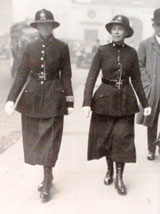Introduction
The antecedents of the Women Police are different from those of their male counterparts. It is impossible to separate the campaign for female police officers from its broader feminist context. From the late nineteenth century, feminists and advocates of social purity (those who sought an equal moral standard based on ideas of female chastity and 'correct' sexual behaviour) viewed the creation of a women police officers as central to their aims.
The searching and care of female suspects in police stations began to be taken over by women in the second half of the nineteenth century. These 'police matrons' were generally the wives of station sergeants. In 1883 a female visitor was appointed by the Metropolitan Police to attend to female convicts on license and women subject to police supervision. Six years later, fourteen women were employed to deal with female prisoners at the police courts. These supervisors were also known as matrons. While the first female police officer was employed on a temporary basis in Portland, Oregon, in the United States in 1905 it took the upheaval of the First World War before any women police officers were appointed in Britain.
A number of documents relating to the women in the Metropolitan Police have survived at the Metropolitan Police Historical Collection. The collection is strong on the early years, which will form the focus of this module.
Objectives
The aim of this module is to help you to:
- Appreciate why the demand for women police officers met with some success during the First World War.
- Have an understanding of the particular role that was given to women police officers.
 WPC 18 Ellis and Inspector Clayden patrolling outside Bow Street Police Station, 1924.
WPC 18 Ellis and Inspector Clayden patrolling outside Bow Street Police Station, 1924.